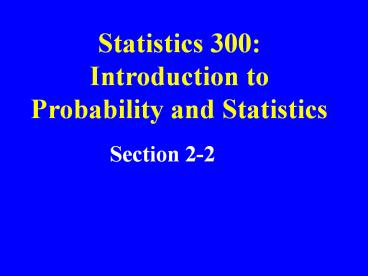Statistics 300: Introduction to Probability and Statistics - PowerPoint PPT Presentation
Title:
Statistics 300: Introduction to Probability and Statistics
Description:
wserver.crc.losrios.edu – PowerPoint PPT presentation
Number of Views:80
Avg rating:3.0/5.0
Title: Statistics 300: Introduction to Probability and Statistics
1
Statistics 300Introduction to Probability and
Statistics
- Section 2-2
2
Chapters 2 and 3
- Describing data
- Exploring data
- Comparing data
3
Describe or Infer?
- Descriptive statistics
- Inferential statistics
4
Descriptive Statistics
- Describe characteristics of (statistics) data
samples as they are without extending their
meaning beyond the data sample - Chapters 2 through 6
5
Inferential Statistics
- Based on a sample or multiple samples, make
inferences (judgments) about the population(s)
from which the sample(s) came. - Chapters 7 through 12
6
Descriptive Statistics
- Distribution
- Center
- Variation
- Position
7
Distribution
- How are the data spread out?
- Where are data plentiful?
- Where are data rarely found?
8
(No Transcript)
9
(No Transcript)
10
Distribution
- Frequency tables
- Pictures
11
Frequency Tables
- Identify categories for the data
- Nominal categories or
- Interval categories
- Count the number of observations in each category
12
Frequency TablesInterval Categories
- Class Limits
- Class Midpoints
- Class Boundaries
13
(No Transcript)
14
Class Limits
- Convenient values representing the range of
values in a class - Lower class limit
- Upper class limit
15
Class Midpoints
- Values that are midway between the lower and
upper class limits of each class - To compute, average the two class limits
16
Class Boundaries
- Values that truly separate one class from the
next - To compute average the upper class boundary and
the following lower class boundary
17
Frequency Tables
- Frequency
- Relative frequency
- Cumulative frequency
- Cumulative relative frequency
18
Frequency
- Count of the observations that belong to each
class
19
Relative Frequency
- Frequency divided by the total number of
observations
20
Cumulative Frequency
- Sum of the frequencies in the first class through
the current class
21
Cumulative Relative Frequency
- Sum of the relative frequencies in the first
class through the current class
22
Distribution
- Frequency tables
- Pictures
23
Pictures
- Histograms and Bar Charts
- Pareto Charts
- Pie Charts

